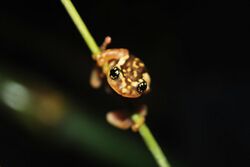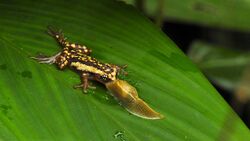Biology:Raorchestes ochlandrae
| Raorchestes ochlandrae | |
|---|---|

| |
| Scientific classification | |
| Domain: | Eukaryota |
| Kingdom: | Animalia |
| Phylum: | Chordata |
| Class: | Amphibia |
| Order: | Anura |
| Family: | Rhacophoridae |
| Genus: | Raorchestes |
| Species: | R. ochlandrae
|
| Binomial name | |
| Raorchestes ochlandrae (Gururaja, Dinesh, Palot, Radhakrishnan, and Ramachandra, 2007)
| |
| Synonyms | |
|
Philautus ochlandrae Gururaja, Dinesh, Palot, Radhakrishnan, and Ramachandra, 2007[2] | |
Raorchestes ochlandrae (common name: Ochlandrae reed frog) is a species of shrub frog in the family Rhacophoridae.[2][3][4] It is endemic to the Western Ghats, India . This species of the oriental shrub frog was first described from Kakkayam Reserve Forest of Calicut district, Kerala state, in the southern Western Ghats in 2007 but has since been recorded at many other sites along the Western Ghats.[2] The specific name ochlandrae refers to microhabitat of the species, bamboo Ochlandra setigera.[2]
Description
Males measure 22–26 mm (0.87–1.02 in) and females, based on only one measured specimen, 23 mm (0.91 in) in snout–vent length. The female was observed in amplexus and was larger than the male it was paired with.[2]
This species is distinguished from congeners by the combination of characters such as body small, elongate, squat and flat; head arched, wider than long; snout short rounded, equal or sub equal to diameter of eye; canthus rostralis rounded; tympanum indistinct but visible; eyes protruding, pupil with striking golden yellow dentition like marks; belly granular; vocal sac unpigmented; fleshy brown to cream yellow dorsum with two distinct golden yellow lateral bands bordered by dark brown from upper eyelid to the posterior part of flanks.[2]
Distribution
The species is endemic to the Western Ghats mountains, reported from parts of the Nilgiris and Anaimalai Hills. It is reported from evergreen forests with bamboos around 600 to 1000 metres above mean sea level.[5]
Taxonomy
Genetic studies indicate that the Ochlandra reed frog is part of an evolutionary clade comprising five lineages including R. ochlandrae, R. chalazodes, R. manohari, R. uthamani, and a lineage described as Raorchestes flaviocularis.[6]
Habitat and conservation
This species inhabits dense stands of the bamboo Ochlandra setigera, growing on forest edges and in more in open habitats. The frogs reside in the hollow tube of internodal region of bamboo about two to three metres above the ground.[1][2]
The species occurs in the Western Ghats mostly along forest streams and other sites where Ochlandra stands remain.[1]
Breeding
The Ochlandrae reed frog has a unique breeding habit of nesting within the hollow internodes of Ochlandra bamboo culms. Although they have been recorded in internodes of different Ochlandra species, breeding has been recorded so far in Ochlandra setigera.[5] The frogs enter the hollow culms through small holes. Calling males may sit outside the entrance holes. While the entrance holes are towards the bottom of the internodes, eggs are deposited on the inside wall of the bamboo towards the upper side. A clutch size of six eggs has been reported. The presence of frogs in the bamboo indicates parental care by males in this species as in the similar Raorchestes chalazodes, with both species also showing direct development of eggs into juveniles.[7][5]
References
- ↑ 1.0 1.1 1.2 IUCN SSC Amphibian Specialist Group (2022). "Raorchestes ochlandrae". IUCN Red List of Threatened Species 2022: e.T136074A166113316. https://www.iucnredlist.org/species/136074/166113316. Retrieved 26 December 2022.
- ↑ 2.0 2.1 2.2 2.3 2.4 2.5 2.6 Gururaja, K. V.; Dinesh, K. P.; Palot, M. J.; Radhakrishnan, C.; Ramachandra, T. V. (2007). "A new species of Philautus Gistel (Amphibia: Anura: Rhacophoridae) from southern Western Ghats, India". Zootaxa 1621: 1–16. doi:10.11646/zootaxa.1621.1.1. http://www.mendeley.com/research/a-new-species-of-philautus-gistel-amphibia-anura-rhacophoridae-from-southern-western-ghats-india/.
- ↑ Frost, Darrel R. (2016). "Raorchestes ochlandrae (Gururaja, Dinesh, Palot, Radhakrishnan, and Ramachandra, 2007)". Amphibian Species of the World: an Online Reference. Version 6.0. American Museum of Natural History. http://research.amnh.org/vz/herpetology/amphibia/Amphibia/Anura/Rhacophoridae/Rhacophorinae/Raorchestes/Raorchestes-ochlandrae.
- ↑ "Raorchestes ochlandrae". AmphibiaWeb: Information on amphibian biology and conservation. [web application]. Berkeley, California: AmphibiaWeb. 2016. http://amphibiaweb.org/cgi/amphib_query?where-genus=Raorchestes&where-species=ochlandrae.
- ↑ 5.0 5.1 5.2 Seshadri, Kadaba Shamanna; Gururaja, Kotambylu Vasudeva; Bickford, David Patrick (2015-01-01). "Breeding in bamboo: a novel anuran reproductive strategy discovered in Rhacophorid frogs of the Western Ghats, India" (in en). Biological Journal of the Linnean Society 114 (1): 1–11. doi:10.1111/bij.12388. ISSN 0024-4066.
- ↑ Vijayakumar, S. P.; Dinesh, K. P.; Prabhu, Mrugank V.; Shanker, Kartik (2014-12-10). "Lineage delimitation and description of nine new species of bush frogs (Anura: Raorchestes, Rhacophoridae) from the Western Ghats Escarpment". Zootaxa 3893 (4): 451–88. doi:10.11646/zootaxa.3893.4.1. ISSN 1175-5334. PMID 25544534. http://biotaxa.org/Zootaxa/article/view/zootaxa.3893.4.1.
- ↑ Seshadri, K.S. (2015). "Rhacophorid Frogs Breeding in Bamboo: Discovery of a Novel Reproductive Mode from Western Ghats". FrogLog 23(4) (116): 46–49. https://www.researchgate.net/publication/287209620.
Wikidata ☰ Q3024195 entry
 |




